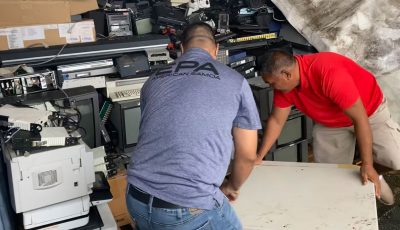1st seasonal high tunnel nearly completed in Kagman
The CNMI’s first seasonal high tunnel will be set on farmer Frank Castro’s farm plot in Kagman with the help of the Natural Resources Conservation Service, under the U.S. Department of Agriculture.
Using its covering, a seasonal high tunnel helps extend the growing season of crops by keeping out excess moisture and insects. This helps local farmers avoid the use of insecticides, helps prevent fungus and mildew from growing on crops, and is expected to keep crops growing even during rainy season.

The entry of Tricia Salcedo of William S. Reyes Elementary School is the official HANMI 30th anniversary logo for this year’s celebration. (HANMI)
Castro’s tunnel was provided through technical and financial assistance through the NRCS Environmental Quality Incentives Program, or EQIP. According to NRCS senior conservationist Kendall B. Hicks, this will be the first one built in the CNMI.
Ten or 12 more tunnels are also ready to be contracted, according to Hicks.
The tunnel, with its ability to create more favorable conditions for crops, is described as perfect for lettuce and also kale, a vegetable now high in demand but shipped to Saipan from off-island.
During the tour last week, Hicks and Lawrence led Pacific Islands area director Bruce Petersen, other government agency individuals and interested commercial farmers to several of EQIP projects on island.
One stop was Castro’s farm in Kagman, where NRCS is also helping the farmer build gutters for the tunnel, which will assist in collecting rainwater. The water will be pumped into two 5,000-gallon storage reservoirs.
As of last week, the work was described as 90 percent done. Missing from the structure last week was the tunnel’s plastic covering.
Castro, who has one of the oldest farms on Saipan, said he aims to grow leafy vegetables with the tunnel.
Per NRCS requirements, the materials grown have to be in the soil, and cannot be grown in concrete or on a table. Plants would have to go into the ground.
The rainwater irrigation is also said to be healthier for the local crop, as compared to using the heavy mineralized water from the public water system.
Hicks also said this mineralization is known to clog drip emitters in local hydroponic systems, forcing them to replaced for thousands of dollars in costs.
On top of that, the harvesting and re-using of water is expected to save farmers thousands of dollars a year in utility charges.
“This is a great thing,” said Lawrence.
“There is no silver bullet,” he told individuals on the tour, when it came to projects NRCS is assisting with. He said they try to “respond to the diversity of needs to meet your main objectives.”
The NRCS tour also stopped at James Matsumoto’s tilapia farm on Capital Hill. For Matsumoto, NRCS is providing technical and financial help to build a 5,060-square foot “water harvesting catchment” roof over Matsumoto’s aquaculture farm. This will consist of a gutter network and series of water tanks that Matsumoto aims to use to start his own hydroponic farm. Hicks called this development “leading edge technology for the island.”
To contact Hicks, or NRCS, for more information call (670) 233-3415 ext. 100.


























